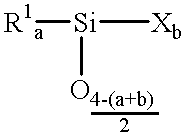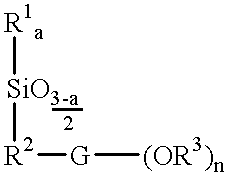(Meth)acrylate esters of organosiloxane polyols, process for their preparation, and their use as radiation-curable materials
a technology of organosiloxane polyols and acrylate esters, which is applied in the field of (meth)acrylate esters of organosiloxane polyols, process for their preparation, and their use as radiation-curable materials, can solve the problems of increased reaction steps, increased energy costs, and increased storage cost, and achieves minimal modification density and increased reactivity.
- Summary
- Abstract
- Description
- Claims
- Application Information
AI Technical Summary
Benefits of technology
Problems solved by technology
Method used
Image
Examples
example 1
a) Addition Reaction of 1,1,1-tris(hydroxy-methyl)propane Monoallyl Ether with a Siloxane Having Lateral Si--H Functional Groups
In a 1 l four-necked flask equipped with intensive condenser, thermometer and dropping funnel, 452 g (+30% excess) of 1,1,1-tris(hydroxymethyl)propane monoallyl ether together with 10 ppm of diaminocyclobutanedicarboxylicplatinum as catalyst were heated to 100.degree. C. in an inert atmosphere. When the temperature had been reached, 672 g of terminally Si--H-functionalized polydimethylsiloxane of average chain length N=10 and of the general formula HMe.sub.2 SiO(SiMe.sub.2 O).sub.8 SiMe.sub.2 H were added dropwise over the course of 30 minutes. After the end of the addition the reaction mixture is stirred at 100.degree. C. until, after about 3 h, a conversion of >99.5% was obtained. Filtration to remove residues of catalyst and removal of the volatile reaction byproducts by distillation at 150.degree. C. / 0.1 bar gave an oil of low viscosity, about 350 mPas,...
example 2
In the manner described in Example 1, 238 g of a laterally Si--H-functionalized polydimethylsiloxane of average chain length N=10 and of the general formula Me.sub.3 SiO(SiMe.sub.2 O).sub.5 (SiHMe.sub.2).sub.3 SiMe.sub.3 were reacted with 226 g of 1,1,1-tris(hydroxymethyl)propane monoallyl ether using 10 ppm of cis-dichlorobis(pyridine)platinum and 23 g of n-butanol. After 5 hours of stirring at 100.degree. C. the conversion was >99.5%.
In order to esterify the hydroxyalkylsiloxane with acrylic acid, in the same way as described in Example 1b), 220 g of the terminal hydroxyalkylsiloxane are reacted with 53 g of acrylic acid (20% excess) in 140 ml of cyclohexane with the addition of 100 ppm of methylhydroquinone and 0.5% of trifluoromethanesulfonic acid. The reaction product was worked up by neutralization with 2% strength sodium carbonate solution, filtration and distillation.
According to the results of .sup.29 Si--NMR and .sup.13 C--NMR spectroscopy the end product has the following...
example 3
Equilibration of Polysiloxanes Containing Acrylic Ester Groups to Higher Chain Lengths.
150 g of the compound described in Example 1b) were reacted at 60.degree. C. for 10 hours together with 802 g of a mixture of octamethylcyclotetrasiloxane and decamethylcyclopentasiloxane and with 0.7 g of trifluoro-methanesulfonic acid. Then 14 g of sodium hydrogen carbonate were added and the mixture was stirred at an ambient temperature of 60.degree. C. for 2 hours. Filtration and removal of the volatile reaction products at 120.degree. C. / 0.1 mbar give a liquid of low viscosity.
According to the results of .sup.29 Si--NMR and .sup.13 C--NMR spectroscopy the end product had the following structure: ##STR13##
PUM
| Property | Measurement | Unit |
|---|---|---|
| Fraction | aaaaa | aaaaa |
| Fraction | aaaaa | aaaaa |
| Fraction | aaaaa | aaaaa |
Abstract
Description
Claims
Application Information
 Login to View More
Login to View More - R&D
- Intellectual Property
- Life Sciences
- Materials
- Tech Scout
- Unparalleled Data Quality
- Higher Quality Content
- 60% Fewer Hallucinations
Browse by: Latest US Patents, China's latest patents, Technical Efficacy Thesaurus, Application Domain, Technology Topic, Popular Technical Reports.
© 2025 PatSnap. All rights reserved.Legal|Privacy policy|Modern Slavery Act Transparency Statement|Sitemap|About US| Contact US: help@patsnap.com



